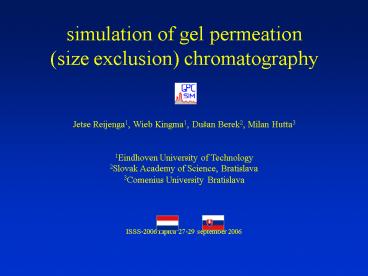simulation of gel permeation - PowerPoint PPT Presentation
1 / 12
Title:
simulation of gel permeation
Description:
(size exclusion) chromatography. Jetse Reijenga1, Wieb Kingma1, Du an Berek2, Milan Hutta3 ... Demonstrate and visualize the influence of following parameters on ... – PowerPoint PPT presentation
Number of Views:246
Avg rating:3.0/5.0
Title: simulation of gel permeation
1
simulation of gel permeation (size exclusion)
chromatography Jetse Reijenga1, Wieb Kingma1,
Duan Berek2, Milan Hutta3 1Eindhoven
University of Technology 2Slovak Academy of
Science, Bratislava 3Comenius University
Bratislava ISSS-2006 Lipica 27-29 september
2006
2
purpose of the simulator
- Demonstrate and visualize the influence of
following parameters on chromatographic results
and interpretation - Choice sample polymer, molar mass, distribution
- Choice of column parameters
- Choice of instrument parameters
- target audience
- Polymer scientists
- Chromatographers
- Teachers of separation science
- Students
3
instrument parameters that can be manipulated
and trained
- flow rate (0.1-10 ml/min, default 1 ml/min)
- injection volume (1-1000 ?l, default 10 ?l)
- temperature (25-220 ºC, default 40 ºC)
- column length (50-1200 mm, default 300 mm)
- column ID (2-20 mm, default 7.5 mm)
- connection (dead) volume (0-1000 µl)
- detector type (Refractive Index, Viscosity,
Density, Lightscatter - detector volume (1-1000 µl)
- detector path length (1-25 mm)
- detector time constant (0.01-5 s)
4
column types (default size 300x7.5 mm)
PS calibration typical for commercially available
columns
5
sample parameters
- type of polymer
- molar mass (1,000 - 10,000,000 g/mol)
- sample either single polymer of variable
distribution or mix of infinitely narrow
distributions of several different polymers - distribution function (Poisson, Lognormal or
Flory) - sample concentration (0-1000 mg/ml)
PS (as calibration reference), PMMA, PEMA, PBMA,
PiBMA, P2EHMA, PC10MA, PMA, PEA, PBA, P2EHA,
PiBoMA, PVA, PCL, PC etc
6
modeling retention dispersion
- calibration through PS as a reference using
polynomal fit to the - calibration curves from the manufacturer
- Ve A B.LogM C.LogM2 D.LogM3 E.LogM4
F.LogM5 - other polymers i modeled using K and a
coefficients - log(MPS) (1/(aPS 1))log(Ki/KPS) ((ai
1)/(aPS 1))log(Mi) - K and a coefficients (THF, 25ºC) were taken from
literature - detailed modeling of chromatographic peak
broadening - simulation of influence of extra-column
broadening (injection, connections, detection)
7
universal calibration
8
choose column.
9
choose detector
10
bandbroadening details
11
conclusions
- Using one can
- Visualize all retention and dispersion effects
- Validate experimental setup
- Check sensitivity of results for many operating
parameters - Extrapolate current instrument specifications
- Perform hypothetical experiments
http//chem.tue.nl/ce
12
Thank you
Thank you































